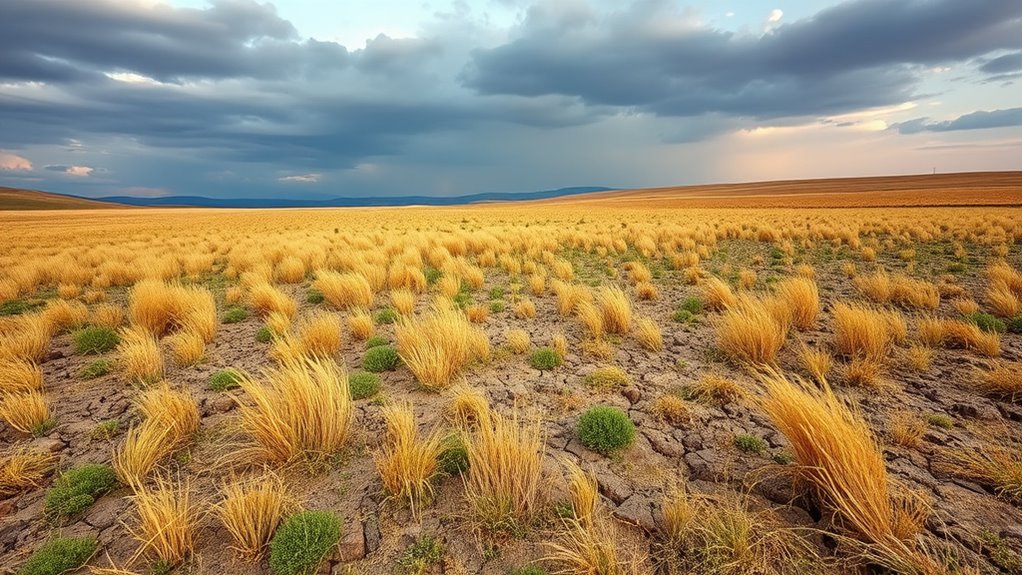To evaluate pasture quality after a drought, start by visually inspecting plant health for signs like wilting, discoloration, or sparse growth. Test soil fertility and moisture levels to identify deficiencies or compaction. Measure forage biomass and check for invasive species or weeds. Compare current conditions with pre-drought benchmarks to assess recovery progress. Paying attention to root health and soil conditions helps determine resilience. Keep exploring to discover effective strategies for restoring your pasture successfully.
Key Takeaways
- Conduct visual assessments for signs of drought stress, discoloration, wilting, or dead patches in the pasture.
- Measure forage biomass density through clipping samples and compare with pre-drought levels.
- Test soil and forage nutrient levels to identify deficiencies or imbalances affecting pasture quality.
- Monitor species composition and diversity to detect shifts indicating ecosystem health decline.
- Evaluate soil moisture and health indicators, including compaction and microbial activity, for recovery potential.
Assessing Visual Signs of Drought Damage

When drought conditions occur, observing your pasture closely can reveal early signs of stress. Look for visual color changes in the grass; dull, grayish, or yellowing patches often indicate water deficiency. Leaf wilting is another key sign—if leaves appear droopy or limp despite recent rain, your pasture is likely under drought stress. These symptoms appear quickly and serve as warning signals that your forage plants are struggling. Pay attention to uneven color or wilting patterns across different areas, which can help you identify where water stress is most severe. Recognizing visual indicators of drought damage helps you respond promptly and implement appropriate management strategies to protect your pasture. Early detection through these visual signs allows you to take timely action, such as adjusting grazing management or providing supplemental water, to minimize pasture damage and promote recovery. Monitoring drought stress signs regularly can also help anticipate further deterioration and plan for long-term recovery efforts, especially when combined with an understanding of pasture resilience. Awareness of how plant health indicators manifest under drought stress can further enhance your ability to make informed decisions for pasture management.
Analyzing Soil Fertility and Nutrient Levels
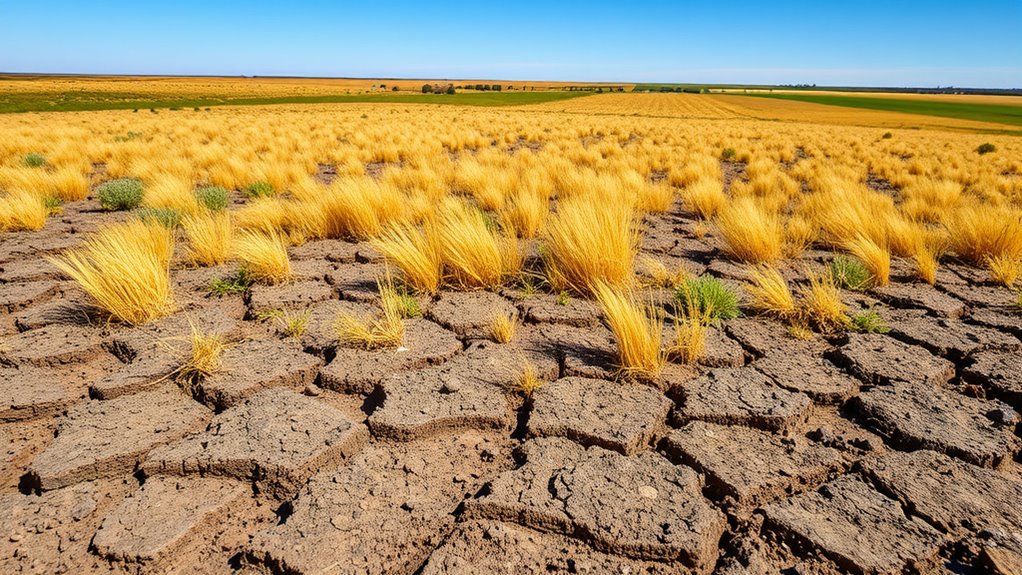
To guarantee your pasture remains productive and healthy, analyzing soil fertility and nutrient levels is essential. Begin by testing your soil to identify deficiencies in key nutrients like nitrogen, phosphorus, and potassium. This helps determine if soil amendments are needed to restore balance. Pay close attention to pH levels, as pH adjustment can improve nutrient availability and promote healthy plant growth. If your soil is too acidic or alkaline, applying lime or sulfur can help correct the pH. Regular testing allows you to tailor your fertilization plan effectively, ensuring your pasture recovers from drought stress. Incorporating soil health practices such as cover cropping and organic matter addition can further improve soil structure and fertility. Additionally, understanding soil nutrient cycling can enhance your management strategies by highlighting how nutrients are retained and released in the soil system. Monitoring soil microbial activity can also provide insights into soil health and nutrient availability, supporting more informed management decisions. Engaging in soil testing regularly can help detect emerging deficiencies early, allowing for timely interventions that promote pasture recovery. Implementing soil nutrient management strategies based on test results can optimize nutrient use efficiency and minimize environmental impacts. Proper nutrient management through soil analysis supports robust growth, enhances resilience, and boosts overall pasture quality, setting a strong foundation for future forage production.
Monitoring Forage Composition and Biomass
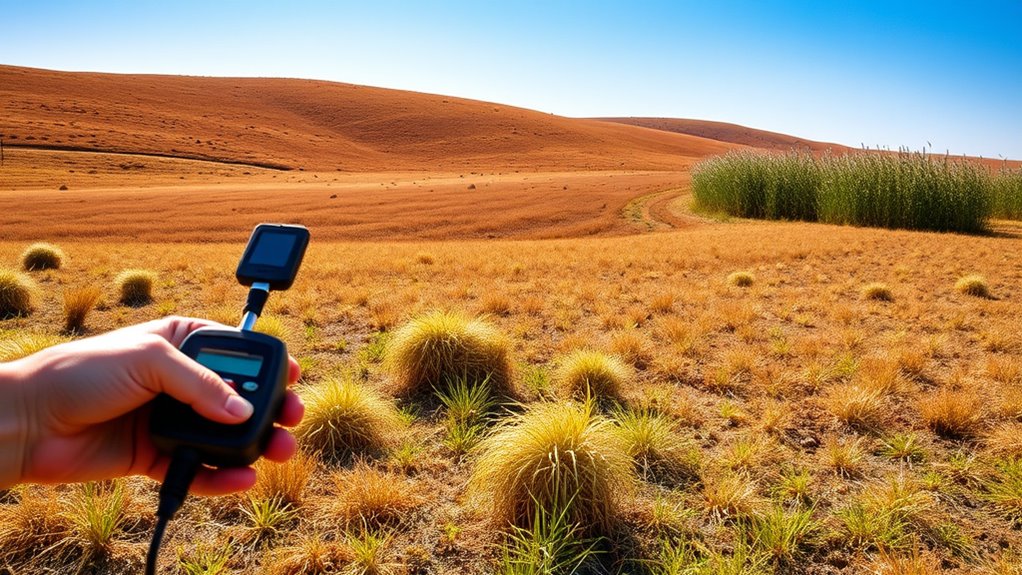
Monitoring forage composition and biomass is essential for maintaining a productive pasture, as it provides real-time insights into the health and quality of your forage crops. By regularly evaluating your pasture species and biomass, you can adjust grazing patterns to optimize growth and prevent overgrazing. This helps ensure a balanced mix of grasses, legumes, and other forage types, especially after drought conditions. Keep an eye on the proportion of different species to identify any shifts that could affect forage quality. Use simple methods like clipping samples or visual inspections to gauge biomass levels. Understanding these dynamics allows you to make informed decisions about grazing rotation, reseeding, or supplementing feed. Consistent monitoring keeps your pasture resilient and productive throughout recovery. Recognizing the importance of resources and tools can also aid you in managing the stress associated with pasture management challenges. Regular assessment of forage composition helps detect changes that could impact nutrient availability and overall pasture health.
Checking for Signs of Plant Stress and Disease

To guarantee your pasture stays healthy, you need to look for visual signs of stress like yellowing, wilting, or stunted growth. Spotting disease indicators such as spots, mold, or unusual markings can prevent further spread, while checking soil and root health reveals underlying issues. Addressing these signs early helps maintain vigorous, productive pastures. Incorporating Fokos can also improve water management and soil stability, supporting overall pasture resilience. Utilizing remote monitoring tools from digital platforms can help track pasture conditions more effectively. Creating a calm, inviting environment in nearby farm buildings can also promote overall herd health and productivity.
Visual Plant Stress Signs
Recognizing signs of plant stress is essential for maintaining pasture health and productivity. Visual cues can reveal how drought or other stressors affect your pasture. Look for changes in pasture aesthetics, like uneven growth or thinning patches. Color changes are key indicators—yellowing or browning grass signals dehydration or nutrient deficiencies. You might notice:
- Wilting or drooping leaves
- Patches of discolored or pale grass
- Thin or sparse plant growth
- Stunted or uneven plant development
These signs help you identify stress early, allowing timely intervention. Keep an eye on overall color and crucial vitality, as subtle shifts can indicate underlying issues. Monitoring these visual plant stress signs is similar to evaluating asset health in a Gold IRA, where early detection can prevent significant losses. Additionally, understanding watering techniques and adjusting for environmental factors can improve pasture resilience. Proper soil management practices can also enhance water retention and reduce drought impact. Implementing drought mitigation strategies can further support pasture recovery efforts. Regular observation and early intervention are key to preventing long-term pasture damage and ensuring sustainable grazing. By monitoring these visual plant stress signs, you can better assess pasture conditions and plan effective recovery strategies.
Disease Indicators and Symptoms
How can you tell if your pasture is affected by disease? Look for visible signs like discolored, wilting, or dead patches of grass. Fungal pathogens often cause spots, mold, or fuzzy growths on leaves and stems. You might notice patches where plants are stunted or die prematurely, indicating possible disease. Pest infestations can weaken plants, making them more susceptible to fungal infections. Check for unusual lesions, powdery coatings, or soft, rotting areas. Keep an eye out for sudden changes in plant color or texture, which can signal underlying issues. Early detection of these disease indicators helps prevent further spread, so regularly inspect your pasture for these symptoms, especially after drought stress weakens plant defenses. Understanding symptom recognition can improve your ability to identify and manage plant health issues promptly. Additionally, monitoring plant stress signals can help you catch problems before they become severe.
Soil and Root Health
Ever wonder if your pasture’s soil and roots are healthy? Healthy soil microbiomes and strong root penetration are crucial for pasture resilience after drought. Signs of trouble include sparse root growth, which limits nutrient uptake, and poor soil structure that hampers root penetration. You should also check for visible signs of stress, like discoloration or wilted plants, which can indicate disease or nutrient deficiencies.
- Examine soil for compaction or crusting that restricts root growth
- Look for roots that are shallow or brittle, signaling weak soil health
- Test soil microbiome activity to ensure beneficial microbes are thriving
- Observe plant vigor—wilting or patchy growth may reveal underlying issues
Evaluating Regrowth Potential and Root Health
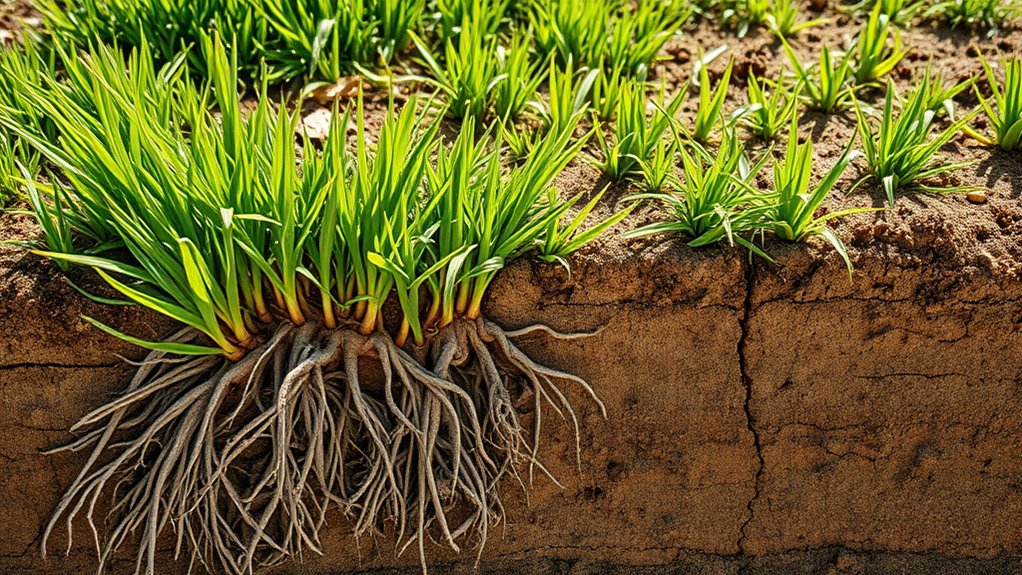
To assess regrowth potential, check the integrity of the root system, looking for signs of damage or weakness. Observe new growth as an indicator of the pasture’s importance and ability to recover. Additionally, monitor soil moisture levels to guarantee conditions support healthy root development and future growth.
Root System Integrity
Evaluating root system integrity is essential for understanding a pasture’s ability to recover and thrive after grazing or environmental stress. Healthy roots support strong regrowth and resilience, while signs of root decay indicate potential problems. To assess root health, examine how well roots are anchoring plants and look for areas of decay or deterioration. A robust root system shows signs of active root regrowth, signaling good recovery potential. Conversely, extensive root decay weakens plants and hampers regrowth, making recovery difficult.
- Check for soft, brown, or rotten roots that suggest decay
- Look for new, white roots indicating active regrowth
- Assess root density and depth for stability
- Watch for signs of disease or pest damage affecting roots
New Growth Indicators
New growth indicators provide valuable insights into a pasture’s regrowth potential and overall root health. By observing growth patterns, you can assess how well the pasture is recovering after drought stress. Look for consistent new leaf emergence, which signals active growth and healthy root systems capable of supporting new shoots. Rapid or uniform growth often indicates strong resilience, while irregular or sparse new leaf development suggests compromised root health or limited resources. Monitoring these signs helps you determine if the pasture has the capacity to rebound or if additional management interventions are necessary. Focusing on growth patterns and new leaf emergence offers a straightforward way to gauge pasture robustness and guide your grazing or reseeding decisions effectively.
Soil Moisture Levels
Understanding soil moisture levels is essential for evaluating a pasture’s ability to recover and support healthy root systems. Adequate moisture helps roots grow deeper, improving drought resilience. After drought, soil compaction can restrict water infiltration, reducing moisture availability, while organic matter influences water retention and soil aeration. You should assess moisture levels regularly to identify dry spots or overly saturated areas.
- Check soil moisture with a probe or feel test to gauge water availability
- Look for signs of soil compaction that hinder water movement
- Improve organic matter through compost to enhance moisture retention
- Monitor root growth and color as indicators of soil health and moisture status
Testing Forage Nutritional Content
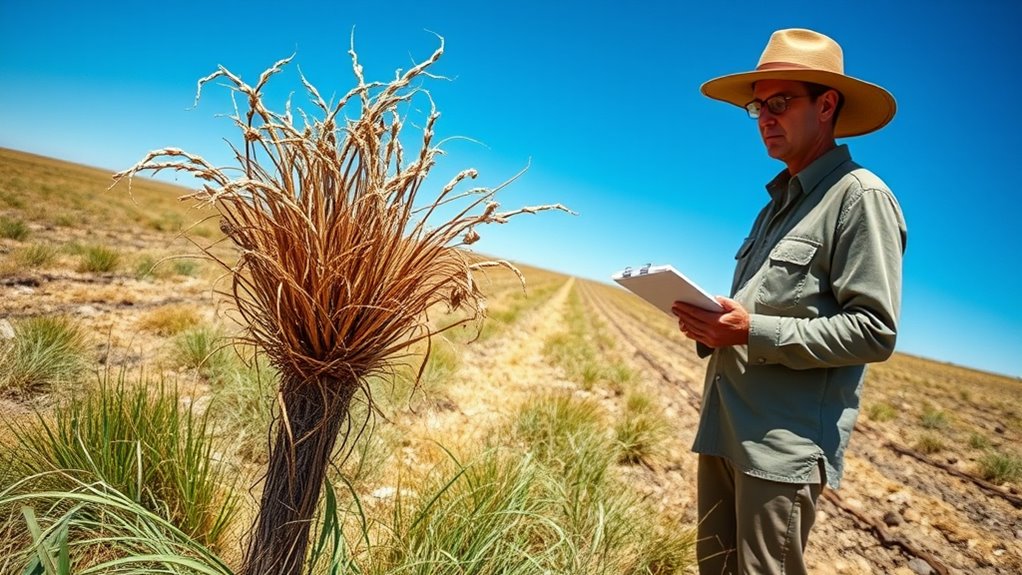
Testing forage nutritional content is essential to determine if your pasture provides the necessary nutrients for healthy livestock. By analyzing samples of different pasture species, you can identify which plants offer ideal energy, protein, and mineral levels. This information helps you adjust grazing management strategies, ensuring animals receive a balanced diet and prevent overgrazing of high-quality forage. Regular testing reveals how drought stress impacts forage quality, highlighting areas needing reseeding or fertilization. Keep in mind that pasture species vary in nutrient content, so monitoring allows you to select the best plants for your livestock’s needs. Incorporating forage testing into your management plan supports sustainable grazing practices and promotes livestock health, especially after drought conditions that may have depleted nutrient reserves.
Observing Soil Moisture and Water Availability
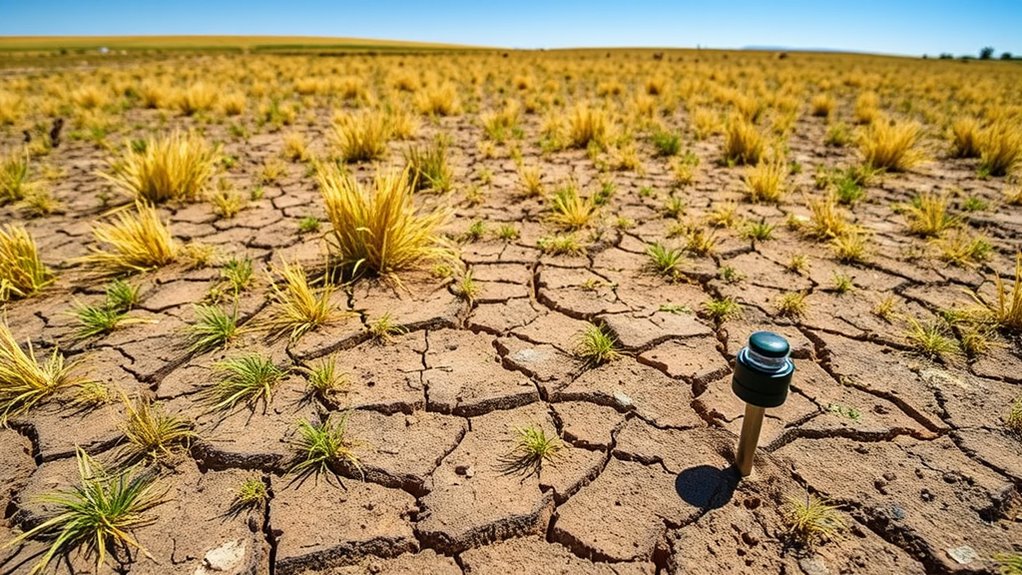
Monitoring soil moisture and water availability is essential for maintaining healthy pastures, especially during periods of drought or dry weather. You should regularly check soil moisture levels to prevent drought stress and guarantee ideal growth. Pay attention to the soil microbiome, which influences water retention and nutrient availability. Healthy soil microbiomes improve water absorption, making your pasture more resilient to dry conditions.
Regularly check soil moisture and support healthy microbiomes to boost pasture resilience during dry periods.
Consider these key actions:
- Use soil moisture sensors for real-time data
- Observe soil texture for water retention capacity
- Conduct simple soil tests to gauge moisture levels
- Monitor plant health for signs of water stress
Identifying Invasive or Unwanted Plant Species
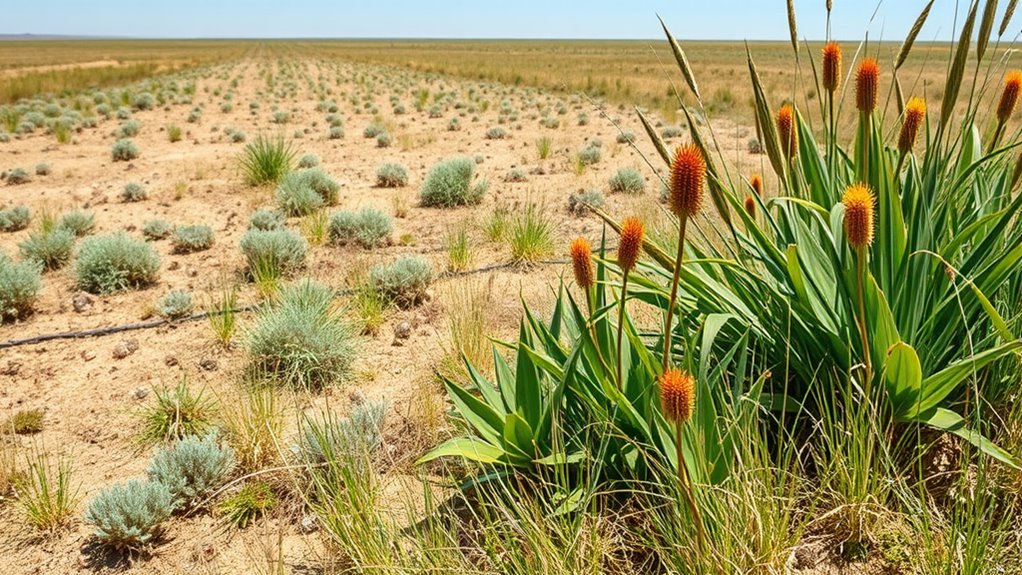
Identifying invasive or unwanted plant species is a crucial step in maintaining healthy pastures. Early detection helps you prevent these plants from overpowering native grasses and reducing forage quality. Use invasive species identification techniques to spot aggressive plants that spread quickly and disrupt the ecosystem. Focus on plants that differ in leaf shape, growth habit, or color from your desired pasture species. To assist, review this quick reference:
| Invasive Species | Unwanted Plant Control |
|---|---|
| Fast-growing, tall weeds | Remove by mowing before seed set |
| Unusual leaf patterns | Hand-pull or spot-treat with herbicide |
| Dense patches | Improve pasture diversity |
Regular monitoring ensures you catch invasions early and take effective action, safeguarding your pasture’s productivity.
Comparing Current Pasture Conditions to Pre-Drought Benchmarks
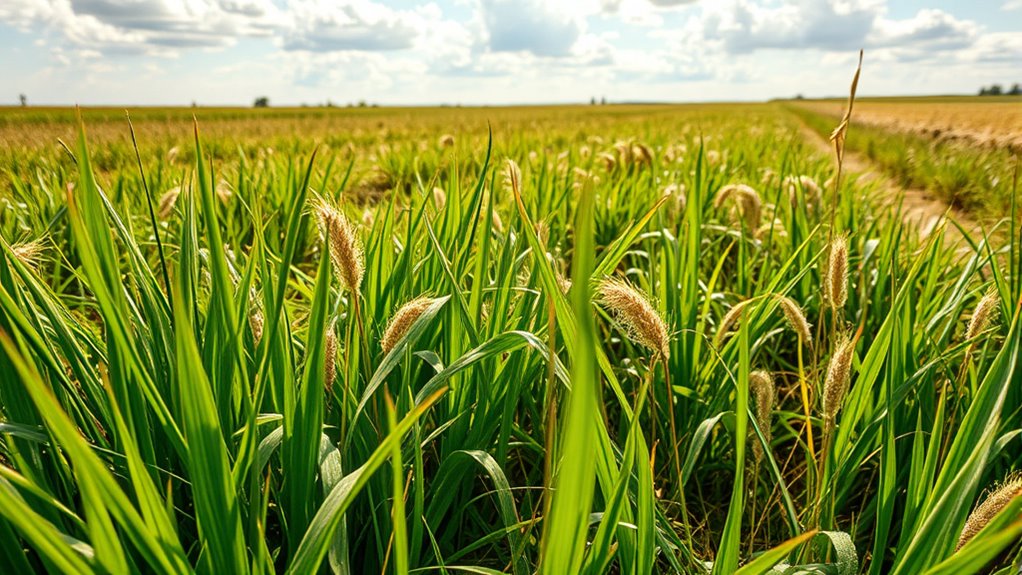
To assess how your pasture has changed, start by comparing current biomass levels to pre-drought benchmarks. Next, look at shifts in nutrient content to determine if the forage quality has declined. These comparisons will help you identify areas needing management adjustments to restore pasture health.
Pre-Drought Pasture Metrics
Evaluating pre-drought pasture metrics provides a essential baseline for understanding how current conditions compare to healthy, established benchmarks. Before the drought, you likely observed diverse pasture species, supporting strong resilience and productivity. Key metrics include pasture species diversity, which reflects ecosystem health, and grazing pressure, indicating how intensively livestock utilized the land.
- Measure species richness and evenness to assess diversity
- Review previous forage production levels and biomass density
- Analyze prior grazing pressure to understand stock impact
- Document soil health and nutrient levels before drought onset
These metrics help you identify declines or shifts in pasture composition and productivity. Recognizing these pre-drought benchmarks allows for more accurate assessments of recovery progress and guides future management strategies to restore pasture health effectively.
Current Biomass Comparison
Comparing current pasture biomass to pre-drought benchmarks reveals how well the land has recovered or declined. You’ll want to measure biomass density to assess the amount of forage available per unit area. Reduced biomass density indicates a decline in forage volume, which can limit grazing capacity. By evaluating current forage volume against pre-drought levels, you can identify areas where pasture growth has lagged. This comparison helps determine if recovery efforts are effective or if additional management is needed. Keep in mind that significant drops in biomass density suggest that the pasture’s productivity is compromised, impacting livestock feed availability. Regular monitoring of these metrics allows you to make informed decisions to restore pasture health and optimize grazing potential after drought conditions.
Nutrient Content Shifts
Have you noticed changes in the nutrient content of your pasture since the drought? Drought conditions often cause nutrient depletion, leading to lower levels of essential minerals. This shift can create a mineral imbalance, affecting forage quality and animal health. You might observe reduced growth or poorer pasture recovery, signaling nutrient issues. To assess these changes, consider testing your soil and forage samples. Here are key points to watch for:
- Decline in nitrogen, phosphorus, and potassium levels
- Increased risk of mineral imbalances affecting livestock nutrition
- Reduced availability of trace minerals like zinc and selenium
- Altered nutrient ratios compared to pre-drought benchmarks
Understanding these nutrient content shifts helps you identify deficiencies early and plan effective fertilization or soil amendments to restore pasture quality.
Developing a Recovery and Management Plan
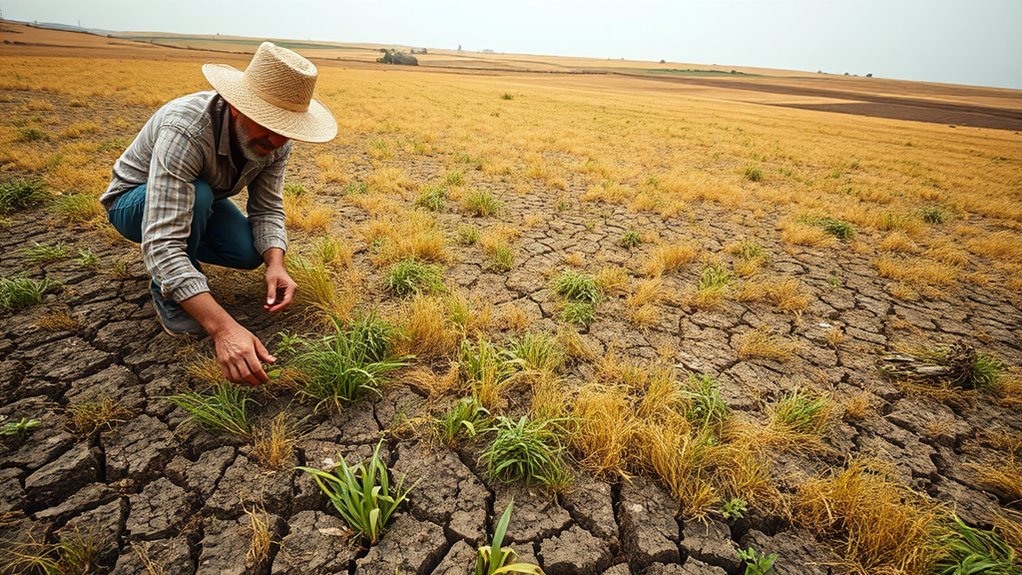
Creating an effective recovery and management plan is essential for restoring pasture quality after degradation. Your plan should prioritize livestock health by providing balanced nutrition and avoiding overgrazing. Implement grazing strategies that rotate livestock between pastures to prevent excessive pressure on any single area. This allows damaged areas to recover and promotes healthy regrowth. Focus on reseeding if necessary, using drought-tolerant species to enhance resilience. Regular monitoring helps you adjust management practices promptly, ensuring ideal pasture recovery. Additionally, improving soil health through fertilization or organic matter addition can accelerate recovery. By carefully balancing grazing intensity with recovery efforts, you reduce further degradation and rebuild pasture productivity, ensuring sustainable land use and livestock wellbeing.
Frequently Asked Questions
How Long Does It Typically Take for Pasture to Recover After Drought?
When asking how long it takes for pasture to recover after drought, consider that soil moisture plays a key role, along with plant resilience. Usually, it takes a few weeks to several months for grasses to bounce back, depending on drought severity and soil conditions. You can speed recovery by improving soil moisture retention and choosing drought-tolerant plants, ensuring your pasture regains health more quickly.
What Are Effective Methods to Prevent Future Drought Damage?
To prevent future drought damage, you should adopt effective strategies like implementing advanced irrigation techniques, such as drip or sprinkler systems, to optimize water use. Additionally, diversify your pasture by introducing different forage species that tolerate drought conditions better. These methods help maintain pasture health during dry spells, reducing vulnerability, and ensuring a more resilient grazing system. Proactive planning with these techniques keeps your pasture productive despite changing weather patterns.
Can Drought Damage Be Reversed or Only Mitigated?
Drought damage can often be mitigated, but reversing it fully is challenging. To enhance drought resilience, you should focus on pasture restoration by improving soil health, selecting drought-tolerant grasses, and managing grazing wisely. These efforts help your pasture recover more quickly and better withstand future droughts. While some damage may be permanent, proactive measures guarantee your pasture remains productive and resilient over time.
How Does Drought Impact Pasture Biodiversity Long-Term?
You might think that drought only causes temporary harm, but it can be a double-edged sword for pasture biodiversity. Long-term, drought stresses native species and depletes soil health, leading to reduced plant diversity. This makes the pasture less resilient and more vulnerable to invasive species. To safeguard your pasture’s future, focus on restoring soil health and promoting native species, which are better equipped to withstand drought conditions and maintain biodiversity.
Are There Specific Forage Species More Drought-Resistant Than Others?
You might notice that some forage species are more drought-resistant than others, thanks to their inherent drought-resistant traits. These species, like certain grasses and legumes, exhibit better forage adaptability, enabling them to survive and thrive under dry conditions. By selecting drought-resistant species, you can improve pasture resilience, maintain productivity, and reduce the risk of overgrazing during drought periods. Focus on these adaptable forages to guarantee sustainable pasture management.
Conclusion
After drought, your pasture’s recovery depends on careful assessment. Did you know that over 60% of pasture productivity can be lost without proper management? By evaluating signs of stress, soil health, and plant diversity, you can develop an effective recovery plan. Regular monitoring ensures you catch issues early, helping your pasture bounce back faster. Remember, proactive steps today can restore your pasture’s productivity and health for years to come.

